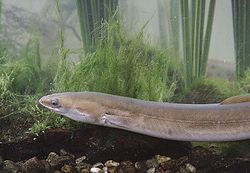Effects of xenoestrogens in eels
Context of the study
It's known that xenobiotic substances can have effects on the endocrine system of animals. These endocrine disrupting compounds can come from sewage treatment effluents. It's uncertain how much these compounds affect wild live in Belgian waters. Through it's carnivorous lifestyle the European eel accumulates many different chemicals throughout his life. During a certain phase of his life (the yellow eel phase) the eel doesn't migrate. Therefore, analysis of residues from eels in this phase of his life would reflect the quality of the environment.[1]
Content of the study
This study investigated the amount of endocrine disruption in European eels of Flemish surface waters. The blood of the eels was analysed for the presence of vitellogenins. Vitellogenins are proteins which are normally only produced by mature female fish. When juvenile or male fish are exposed to endocrine disrupting compounds, they can also produce these proteins.
Main results of the study
Although the eels were exposed to different possible endocrine disrupting compounds (e.g. PCBs, organochlorine pesticides, heavy metals) at different concentrations, no effect of any of these pollutants on the vitellogenin production was detected. Therefore it was concluded that the European eel in the yellow eel phase isn't suited to detect endocrine disrupting compounds through vitallogenin production. This, although there are high concentrations of possible endocrine disrupting compounds present in Flanders.[1]
References
Please note that others may also have edited the contents of this article.
|
